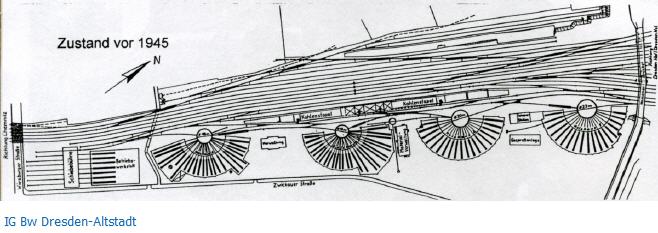1872-1945
The history of Bw Dresden-Altstadt starts in 1872 when a roundhouse for 20 engines and a coal bunker were built at the place of today's famous roundhouse ensemble. These new facilities were some crucial parts of the second extension of "Böhmischer Bahnhof" in the city of Dresden (i.e. the train station for Bohemia-bound services). The "Bohemian station" had been founded and run by the private railway company "Albertbahn" some decades before. It had become insufficient when the "Albertbahn" company was transferred to the state railways of Saxony.
In 1876/77 the coal bunker was extended and roundhouse #2 with 19 tracks was erected. These two loco sheds were exclusively used to park the engines. Any maintainance work was done in the depot located at Böhmischer Bahnhof. A three-storey extension was added to roundhouse #1 in 1884 hosting a high-level water reservoir and recreation facilities for the personnel. A civil servants' house was built in 1891.
Just some few years later, the entire railway facilities in Dresden were fundamentally reconfigured. It had turned out that one central passenger station should be set up to replace various direction-oriented stations spread all over the city. Two further roundhouses were built in the course of these activities (houses #3 and #4) in 1893/94 and an administrative building was placed in between them. A storage building was established between roundhouses #2 and #3, which lateron hosted the locomotive management during the GDR era.
On both sides of the coal bunker arouse three coal piles between tracks #58 and #59 all along the roundhouses. Coaling was conducted by three stationary "Ruge" cranes, one of which is operated until today. The overall capacity of the coal reservoirs was 3,000 tons. In the course of time, any roundhouse was extended to host contemporary (i.e. bigger & longer) engines. As well, all turntables - one in the focus of each roundhouse - were adapted to newly required lengths: that of roundhouse #1 was extended to a platform length of 23 metres, which has not been changed ever since. Those infront of roundhouses #2 and #3 (which do not exist any longer) had a length of 20 metres and 16 metres, respectively. The turntable belonging to roundhouse #4 received a platform length of 16 metres, which is today's length as well.
Any maintainance of locomotives was conducted in the heavy repair works (in German: "Ausbesserungswerk") based in the urban district of Friedrichstadt in Dresden until the mid-1920ies. This divided system had been established by the "royal state railways of Saxony" (or however you might call "Königlich Sächsische Staatseisenbahn" in English): mere storage and recreation in one place on the one hand - and both "light" and "heavy" maintainance in another place on the other hand. It was handed over to nation-wide "Deutsche Reichsbahn" after WW I and continued for some few further years. However, in 1926 the system of locomotive maintainance in depots and repair works was re-organized fundamentally. In the course of this, a new depot building equipped for locomotive maintainance was placed in prolongation of roundhouse #4. (The repair works fulfilled only "heavy" maintainence from that time onwards). It was not designed as a roundhouse but as a rectangular hall housing seven tracks. Hence, a sliding stage was mounted instead of a turntable. According to its function, this ensemble is colloquially denominated as "the repair shop" instead of its formally correct name "house #5". These additional facilities were the last to complete the depot in its maximum size - all space available for railroading in this urban district of Dresden-Plauen had filled up.
By that time, almost all prestigious (formerly) Saxonian classes of steam locomotives for express passenger trains were domiciled in Dresden-Altstadt, most importantly the "pacifics" of class 18.0 and the "mikados" of class 19.0. Lateron, equivalent engines inherited from the former Prussian state railways (classes 17 and 39) were added. Not to forget, the most up-to-date passenger express steam locomotive classes developed by Deutsche Reichsbahn - classes 01, 03 and 61 - were located here as well. In the hey days, an average number of 120 steam engines resided in Dresden-Altstadt. All these locos were the pride of Dresden-Altstadt and hauled all well-known international and national express trains which contacted Dresden. By name, one of them was the famous "flying steam train Henschel-Wegmann Zug": it was operated between Dresden and Berlin Anhalter Bahnhof, hauled by Henschel-built 61 001 and equipped with a special set of four waggons developed by Wegmann - it had a scheduled travelling time of as few as 102 minutes between the two metropoles. Apart from these highlights, Dresden-Altstadt gave home to numerous passenger train engines to haul district trains, local and conventional suburban trains as well as what we might today call a "rapid commuter transit service": classes 38.2-3 (formerly Saxonian class XII H2), 38.10-40 (Robert Garbe's Prussian P8), 86, 93 and 98.0 (formerly Saxonian class I TV, the famous "garden spider" bound for services on mountainous "Windbergbahn").
After Hitler had occupied and annected Bohemia and Moravia, classes located in these areas as well hauled trains between Decin/Tetschen or Usti nad Labem/Aussig and Dresden in parallel to Dresden's locos. They attended the depot in Dresden-Altstadt for scheduled recreation and occasional light maintainance.
In the late 1930ies, the depot facilities at the freight and marshalling yard in Dresden-Friedrichstadt were designed in a contemporary style, significantly enlarged and relocated. The engine repair shop was opened there in 1940 and several locos and classes left Dresden-Altstadt to be hosted in Dresden-Friedrichstadt from then on. In Dresden-Altstadt, roundhouse #3 was abandoned as a home for locomotives. Its turntable was removed, all original tracks removed, two loading sidings installed and the hall itself re-used as a storage room for goods vital to the war.


